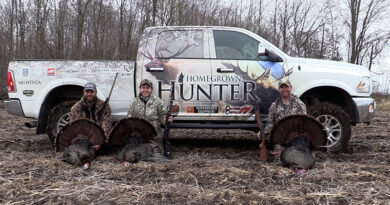Crank Bait Crush
One of my favourite ways to locate fish in the spring and early summer is throwing a crank bait. What’s a crank bait you may ask? 
A crank bait is a moving bait that you can use to make a lot of casts to cover a ton of water quickly, and entice active fish to strike. There are many different types of cranks, from lipped to lipless, short ones, long ones, fat, skinny, straight, jointed, rattles and no rattles. I know that sounds like a lot to take in but I will try to break it down and simplify when, where and why to use which type of crank bait. There are four basic factors I use when choosing to fish a crank bait.
#1. The action
The action on a crank bait can be basically described as a wobble, the width and speed of which depends on the size and shape of the bait. Usually, the wider the lip and bait profile the more water the bait is displacing which means it will give the bait a wider wobble; I find this is good for warmer weather when fish are not as active. The cranks with thinner lip and bait profile – or even lipless cranks – will have a much tighter wiggle and vibration and I tend to use these in cooler water conditions when the fish are chasing bait.
#2. The depth
Another factor when choosing a crank bait is the depth you are fishing or the depth you want your bait to run. The latter is determined by the size and angle of the lip; the steeper angle and shorter bill crank baits tend to be your shallower running baits. You want to use these if you are fishing shallow water rocks or stumps and run them at a depth where you are making bottom contact or over the top of weed flats. Deflecting these baits off the cover and maybe even pausing after can cause reaction strikes and increase hook ups. The straighter the angle bigger lipped crank baits tend to run deeper. These are great for deeper water drop offs or weed edges and are not only great for casting but also trolling. Most lure companies have the running depths noted on the packaging to make this easier to determine the right bait for the correct depth.
#3. Size and colour
A lot of these baits have the most success when you “match the hatch”, which simply means choosing a colour and bait profile that most resembles the baitfish in your lake. However, you may have more success on overcast days or in dirty water with brighter chartreuse colours so pay attention to the weather and lake conditions in your area. If I had to choose three colours for the Kawartha area, they would be a natural shad or perch type colour pattern, a deep red crayfish colour or a chartreuse.
#4 Rod and Reel
Rod and reel selection is most important when throwing crank baits. You want to have a rod with a very sensitive extra fast tip to feel when the fish takes the vibration off your bait and also gives you flex and a chance to set the hook without pulling it out of the fish’s mouth. That being said, you still want good backbone in the bottom half of the rod to be able to bury the trebles deep when you set the hook. A medium action rod with an extra fast tip is usually the best choice for casting these light baits.
I hope this clarifies some of the muddy waters around crank bait fishing and helps you narrow down your choices when it comes to the millions of crank baits at your local tackle shops. So get out there in the spring and summer months and try cranking! It’s a ton of fun and I’m sure you will have lots of action.
If you have any questions on this article or fishing questions in general you can follow me on Facebook at Williams Outfitters Fishing Guides or on Instagram @williams_outfitters
Best of Luck on your next fishing adventure!
Cheers, and tight lines
Mike Williams




